June Cub Scout Roundtable Issue |
Volume
14, Issue
11
July 2008 Theme |
Theme:
H20hhh!
Webelos:
Aquanaut & Geologist
Tiger Cub
Achievement 2 |
PACK AND DEN ACTIVITIES
WATER SAFETY
Circle Ten
Council
Before you take your pack or den out for any
water-related activities, please read:
Safe Swim Defense
Home Swimming Safety Rules
Water Rescue
Safety Afloat
PLAY SAFE AND HAVE FUN
Circle Ten
Council
Most cities offer recreation swimming at their pools with
qualified lifeguards on duty. Call your city's parks and Recreation Department
or community Services office for specific locations, hours and fees. Some YMCA
offices open pools outside their normal facilities for more affordable fees.
Call the YMCA near you for more information. Some pools require letting them
know ahead of time if you are planning to bring a large group so that they can
arrange to have more lifeguards on hand.
Things to Do
Alice, Golden
Empire Council
«
If you’re lucky enough to have a rainy day for your den meeting,
take a rainy day hike – dress properly and use all your senses to really
appreciate the rain!
«
On a rainy day, make some quick paper boats and sail them in the
gutter.
«
Take a hike along a stream, or even in it, if it’s safe and you
have the right footgear. Look for differences in the water color, flow, what
animals and plants grow along the stream, what kind of rock, sand or soil the
stream runs along. Try a silent hike to really enjoy the sound of the water –
anyone who spots something interesting just stops and raises their hand so
everyone can enjoy the discovery. Bring along a bag to pick up man-made trash
and keep the stream beautiful.
«
Try the Incredible Journey
under “Theme-Related.” Have a discussion about your journey when you’re done.
«
Call your local water utility for a guest speaker, or arrange a
visit – they always have lots of great ideas, brochures and sometimes even
posters to share!
«
Do a water-related service project, such as stenciling “Do not
dump-Drains to River” signs by storm drains. Contact your local water utility
or go to Project WET or a local Creek Support group for great local ideas.
(There are even grants available to pay for needed supplies) See website for
info.
«
To demonstrate how essential water is for our bodies, have each
boy make a full-size outline of his body, fold it into tenths, and then color in
7 of the 10 spaces with blue to visually show that 70% of our bodies is water!
«
Show the different forms water can take by filling a glass with
water, (liquid) then putting it in the freezer for a few minutes – when you
bring it out, a temporary fog cloud will form (gas). Finish up with a popsicle
treat (solid).
«
Have a “guest expert” from your pack or outside teach boys how to
fish, boating and water safety, or how to make knots that are used in a marine
environment.
«
Invite a handyman to show the boys how to make simple repairs,
find leaks, or install water saving devices. Then boys and parents can make
changes in their own homes.
«
Check with your local water resources department and the US
Environmental Protection Agency for some great posters, brochures, charts,
information and activities you can share with the families in your den and
pack. (On their websites, look for a section specifically for KIDS; they may
also have a section for parents or teachers)
«
Using brochures from the local water department or hints created
from the material under “Theme-Related,” have a den or pack share water saving
hints with the pack or their neighborhood.
«
Cubs or dens could set up a display to demonstrate the amount of
water used and saved when leaks are fixed or out-dated equipment is replaced.
(Seeing a five gallon container of water makes a strong impact, especially if
paired with the cost over a month or year of a simple dripping faucet)
IDEAS FOR PACK
ACTIVITIES:
Baltimore Area Council
- Visit the Baltimore Aquarium (or one near you)
- Have a water balloon battle
- Visit the Goddard Space Flight Center (or
another NASA installation)
- Visit the Flag House (or see the Star Spangled
Banner from Fort McHenry at the Smithsonian or the Betsy Ross House or
something else historical for the Fourth of July)
- Hold a Raingutter Regatta (Check it out in this
section!)
- Visit the C & O Canal (or another water based
historical attraction near you. We visited an historic canal near Dayton,
OH a few years ago)
IDEAS FOR DEN ACTIVITIES:
Baltimore Area Council
- Help clean up a stream
- Go Fishing
- Go for a hike in a local park
(Take plastic grocery bags and leave the
place looking better than you found it!)
- Make blue gelatin with gummy fish for a snack
- Hold walnut shell boat races
Water Fun Ideas
Capital Area Council, TX
A water
carnival A fishing derby
A raingutter regatta A backyard beach party
A sea adventure pirate night A trip to a water theme park
A swim and picnic day at your local park
A visit to the local swimming pool
Raingutter Regatta
Baltimore Area
Council
(See Cub
Scout Activities Book for additional help)
Copy the
picture and enlarge it for easier use CD
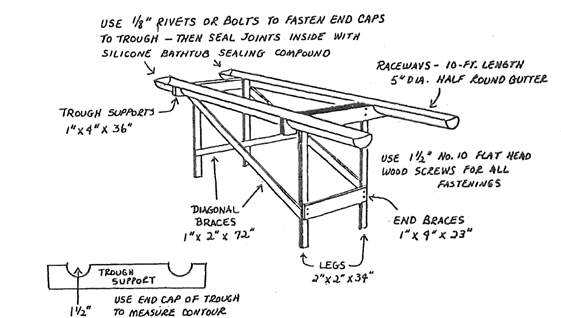
Ahoy mates! You’re watching
the sailing regatta of the century! Although the waterways are only 10-foot
lengths of rain trough filled with water and the ships are a mere six inches
long, each race can be an exciting event. This is a very popular Pack race. Each
Cub Scout makes his own boat (with a parent’s or grandparent’s help) to enter in
the race.
The raceway consists of a
simple frame that supports two 10-foot lengths of rain trough filled with eight
gallons of water. The frame is designed so It can be assembled and disassembled
quickly. The illustration shoes you what it looks like. The material sizes and
fastening details follow.
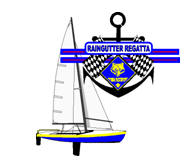
Materials Needed for Double
Raceway:
ü
2 - 10 ft. lengths of 5” diameter half round gutter
ü
4 - End caps for gutter and rivets or bolts to attach end caps to
gutter
ü
2 - Trough supports 1” x 4” x 36” long boards. Cut them out so
that gutter fits snuggly
ü
2 - End braces - 1” x 4” x 23”
ü
4 - Diagonal braces - 1” x 2” x 72”
ü
4 - Legs - 2” x 2” x 34”
ü
1½” #10 flat head wood screws for all fastenings (Bolts could be
used to fasten the braces on the legs to allow for easier disassembly for
storage.)
Fishing Derby
Baltimore Area Council
There are a lot of good games listed
here as alternate activities, don’t miss them!!
Also, there are many specifics for
Maryland in here, but I am sure if you check with your local state officials you
will find many of the same programs wherever you live. Go to the “My Home
State” Baloo for the list of state websites for kids if you don’t know where to
start. CD
There are two kinds of Cub Scout Pack fishing
derbies: both are fun for boys and parents.
ü
One is a partner-and-son
fishing trip to a nearby lake or river where adults and boys can fish off the
bank or in boats. Small prizes are awarded for the biggest fish, smallest fish
and best string.
ü
The other type is a family
outing with games and contests related to fishing. The ideas listed here are for
this kind of derby.
We are quite lucky in the State of Maryland,
that the Department of Natural Resources (DNR) and Fisheries has a program
called "Hooked on Fishing not on Drugs", where the DNR will supply on a loan
basis, rods and reels to Scout units, free of charge. The DNR also has other
resources such as booklets on fishing for youth, the State laws on fishing in
Maryland, and other literature. The Fisheries can stock ponds and streams for
events if open to the public. The also have flyers, posters, and other items
that can be used in your derby. The DNR police are a good source who will visit
a Pack Meeting and explain fishing laws, conservation, water safety, etc.
In the Baltimore Area Council, the Bass
Masters will do demonstrations on casting and fishing methods. This organization
has several programs depending on the local group which the boys can win prizes
and other awards. In the past, the owner of a local bait shop has supplied worms
or bait for Scouting activities. The State of Maryland has several other
programs which are coordinated through the DNR, one such program is "My First
Fish" for anyone catching their first fish in Maryland. A form is filled out and
a certificate is sent to the fisherman. A second is, “Catch and Release,” if the
Cub catches and then releases a fish (alive) there is a patch and certificate
available that can be obtained from the DNR.
The fishing derby committee should follow Cub
Scout guidelines for planning special events. Planning includes securing a site,
arranging for transportation, planning activities and obtaining prizes and
arranging for food and equipment. Try special promotional gimmicks such as
invitations in the shape of a fish.
Make identifying signs for each contest area.
Use ropes, posts, colored streamers, and colorful signs to mark game areas.
Consider using a public address system to control the activities, if necessary
and a tape player to provide lively music.
Suggested Fishing Derby Schedule
1:00 - 2:00 Gathering-time activities
2:00 - 3:30 Special contests
3:30 - 3:45 Awards ceremony
3:45 - 5:00 Free time for fishing
5:00 - 6:00 Meal and clean-up
You do not need to buy a lot of expensive
equipment to start with. You just need a rod and reel (or a cane pole), some
line and hooks and a few
weights and floats. You also need a
disgorger, or "hook-out", which is a metal or plastic tool used to take a hook
out of the fishes mouth without hurting the fish.
Tackle for the Job
What about bait?
To catch fish, anglers (fishermen) use some
sort of food, or bait, to tempt fish to bite on the hook. Bait can be real food,
either alive or dead. It can also be an imitation, which is used to trick the
fish. Artificial flies and lures are in this category. So is a piece of
aluminum foil attached to the line.
Knots -
Fishing line is quite smooth and you will
need to learn how to tie special knots that do not slip when tying a hook onto
the line. Always make the line wet before tightening the knot. Test the knot by
pulling from both sides before you start fishing. Have a fisherman teach you
knots that can be used to tie your hook onto you line and then practice them.
Or find pictures that show the knots and practice them.
Games for your Fishing Derby
You may want to have some alternate
activities ready to go in case the fish are not biting that day. Or younger
Scouts become restless.
Guessing Contest:
How many fish eggs are in the jar? Use marbles for the eggs. The winner gets the
jar of marbles.
Snapping Fish Game:
This game requires several fishing poles with sinkers and a piece of foam rubber
attached to a 3 -by-4 foot line. Also, have several mousetraps set to spring.
Object of the game is to set off a trap by hitting it with the foam rubber
without getting the line caught in the trap.
Fish & Net Game:
Three to five Cubs join hands to catch fish (Cubs) by surrounding individual
players. Those who are caught become a part of the "net". The last five Fish
caught make up the net for the next game.
Sardines:
Select one Cub to be "It". He hides while the other players count to 100. Then
they all search for him. When someone finds ``It" they hide with him. Continue
until the last Cub locates "It". The first Cub that found "It" is the new "It"
for the next game.
Fishpond Games:
An infinite variety of games are possible with a "hook", a line, and a pole.
Make hooks from coat hanger wire, paper clips, magnets, or even sticky gloop.
Cut fish from felt, cardboard, wood, or sheet metal. The players can catch the
fish by hooking them and lifting them out of the Ocean or stream. Fish can be
marked with different point values or different colors can be worth different
points, or even feats of skill (do a head-stand or hand-stand).
Crab Relays:
Have the first Cub in each line sit on the floor with his back to the finish
line. On a signal, he walks backwards on his hands and feet with his body
parallel to the floor. When he reaches the finish line, he stands up and runs
back and touches the next player. Who repeats the action, the first team to
finish wins.
Rope Throw Rescue:
Each Den has a coil of rope or clothesline and adults representing drowning
persons whom must be rescued. The Cubs in turn throws the rope to a drowning
person, who grabs it and let go. The player recoils the rope and hands it to the
next player. Repeat until all have been rescued.
There is so much that
can be done at a Pack Fishing Derby. Let your imagination run wild. Other games
can be: Harpooner, where a Cub takes aim at a whale with a broomstick (harpoon).
There is also the Fish Market where the Cubs throw slippery fish to their
teammates who have to stack them (The fish are small nerf footballs that were
soaked in baby oil). Casting competitions, mend fishing nets. A chowder race
where each Den has to put an ingredient into the pot to complete the chowder.
The derby can also be ended with a Crab Feast or Clam Bake.
Special Contests
Reeling Relay:
Dens and families are arranged in relay fashion. The first player on each team
has a fishing pole and reel. On signal, he places the fishing pole and reel on
the ground in front of him, takes the plug and runs to a line 25 feet away,
unwinding the line as he goes. He then runs back, sits on the ground, and reels
in the line. The next member follows and so on, until all have played. First
team finished wins.
Fishing Relay:
The "fishpond" is a large cardboard box turned upside down, with slots cut in
the bottom. In each slot, insert a "fish" cut from cardboard. On each fish mark
a length and weight for it. For each team, you need a cane pole with a 3-foot
string and a bent paper clip for the hook. Team members line up relay fashion,
with the first member holding the pole. On signal he runs to the fishpond and
catches a fish. A judge records the length and weight. The team with the
greatest weight total of fish wins.
Rowing Relay -
Players on each team sit or kneel in a
large cardboard box and propel themselves to the goal line and back by using two
short broomsticks with rubber tips.
Go fishing in the
Lake: Prizes could be given for
biggest fish caught, littlest fish, most fish caught, longest fish caught, etc.
Inexpensive fishing tackle might be used for prizes.
The Incredible Journey
Alice, Golden
Empire Council
“I did this with my den and they had a great
time and wanted to continue the game” – If you ever get the chance to take the
Project WET workshop, don’t hesitate – Lots of great ideas!” Alice
Materials:
ü
9 large dice (could be made from 6” sq. boxes) marked with numbers
1-6;
ü
9 signs to mark stations (could include appropriate pictures) with
a list of where the drop goes next or why it stays at that location; chenille
stems for each person;
ü
9 different colors of pony beads, one for each station, enough for
every person to add a bead each time;
ü
Bell or whistle to mark time to change stations or roll the dice
again
Set Up:
Make station signs,
including the following possible moves for the water drop:
Soil Station:
#1 - water absorbed by
plant; (plant)
#2 – Soil saturated, water
runs into river; (river)
#3 – water filters into
soil; (ground water)
#4-water evaporates into
clouds; (clouds)
#5-water evaporates into
clouds; (clouds)
#6-water stays in puddle on
surface; (stay)
Plant Station:
#1, #2, #3, #4: water
leaves the plant thru transpiration, evaporating (clouds)
#5 , #6: water is used by
the plant (stay)
River Station:
#1-water flows into a lake
(lake)
#2-water filters into soil
(ground water)
#3-water flows into ocean
(ocean)
#4-an animal drinks water
(animal)
#5-water evaporates in heat
(clouds)
#6-water stays in the river
current (stay)
Clouds Station:
#1-water condenses and
falls on soil (soil)
#2-water condenses into
snow, falls on glacier (glacier)
#3-water condenses, falls
into lake (lake)
#4-water condenses, falls
into ocean (ocean)
#5-water condenses, falls
into ocean (ocean)
#6-water clings to dust
particle (stay)
Ocean Station:
#1, #2: water evaporates
into clouds (clouds)
#3, #4, #5, #6: water
remains in ocean (ocean)
Lake Station:
#1-water filters into soil
(soil)
#2-an animal drinks the
water (water)
#3-water flows into a river
(river)
#4-water evaporates into
clouds (clouds)
#5, #6: water remains in
the lake (lake)
Animal Station:
#1, #2: water excreted as
feces, urine (soil)
#3, #4, #5: water is
evaporated from body (clouds)
#6-water incorporated into
the body (stay)
Ground Water Station:
#1-water filters into a
river (river)
#2, #3: water filters into
a lake (lake)
#4, #5, #6: water stays
underground (stay)
Glacier Station:
#1-ice melts and water
filters into ground (ground water)
#2-ice evaporates into
clouds (clouds)
#3-ice melts and water
flows into river (river)
#4, #5, #6: ice stays
frozen in glacier (stay)
Directions:
·
Be sure and explain that this game allows each boy or team to be a
single drop of water – using the dice and moving from station to station, the
boys will learn all the different ways the water drop can travel.
·
They will also learn that the drop may stay in the same form, at
the same station, such as “clouds,” just as a real drop of water might do.
·
Divide the group so each one starts at a different station.
·
They pick up a bead and put on their pipe cleaner, then roll the
dice to see what the drop of water is going to do next.
·
The six numbers under each station are the six numbers on the
die. The word in parentheses is the station where the drop of water (Cub Scout)
goes next.
·
They must wait for the whistle or bell before moving to the next
station (or picking up another bead and rolling the dice again if there water
drop was told to stay in the same form).
·
Remind the boys that they must do whatever the number on the dice
tells them to do, even if that means they stay at the same station for another
turn – if that happens, they get another bead of the same color, then roll the
dice again.
·
Now, if you are used to boys, you will expect quite a reaction to
the Animal Station, #1 and #2 – that whole “bathroom humor” thing. But just
remind them that all animals, including Scouts, must have water to survive!
·
Be SURE to demonstrate playing this game, starting at a
station, adding a bead, rolling the dice and the various instructions the boys
might have to follow – make sure everyone understands so they can have fun and
learn!
·
You may want to set a specific time limit of 10 minutes, or you
might let the boys keep playing till everyone has had a chance to move around to
most stations.
·
After the game, let everyone compare their bead bracelet and talk
about why there was a difference between stations – do they think their water
drop moved in a way a real one might?
·
Lead a discussion about why they may have stayed in a location
more than one turn – do they think that would happen in real life?
Go to the Project WET website,
www.projectwet.org for more great ideas!!
Giant Wind-Up Water Bug
Baltimore Area Council
Materials:
Two
Styrofoam meat trays, 3" long light thin
rubber bands, pencils, scissors, white glue, sharpie marker, colored pencils or
markers.
Instructions:
1.
Cut the bottoms of the meat
trays out and glue them together, making sure that one
of
the trays has the smooth side out.
2.
Transfer the bug and paddle
wheel patterns to the smooth side. Use carbon paper or trace to another sheet of
paper, blacken the backside of the tracing with a #2 pencil or crayon and then
trace over the pattern with a dull pencil.
3.
Cut your bug out of the
Styrofoam being sure to include the notches in the legs for the rubber band.
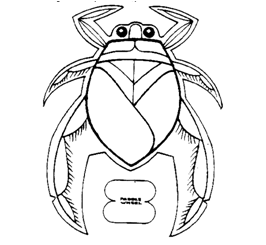
4.
Decorate the bug with
colored markers or pencils.
5.
Stretch the rubber band
between the legs. A thin rubber band that fits without stretching much is
essential.
6.
Slip the paddle wheel in
the middle of the rubber band loop and wind up gently. Placing the paddle wheel
off center will cause the bug to travel in circles.
7.
A toddler's swimming pool
is the ideal place to release your bugs. Try having a Den race.
4 Hats, One “River”
Alice, Golden
Empire Council
Materials:
·
Four sets of cards as above,
including some blank ones, based on whatever body of water is most common in
your area.
·
Four hats to represent four
different kinds of people who would use the water. The farmer could wear a straw
hat, the fisherman a cloth hat with lures on it, the recreational user could
wear a baseball cap, and the industrial user would wear a hard hat.
Instructions:
ü
Divide the group into four
sections; each one chooses a spokesman, who wears their hat.
ü
The group gets a set of the
cards, plus some blank ones they can fill in themselves.
ü
Each group can decide what
features would be good for their use, and what would be harmful.
ü
After 5 minutes, each spokesman
can report on what the group decided.
ü
To use the cards as part of
competition between groups, each person chooses a card when it's their turn to
wear the hat, then posts the card on the wall, and the other groups get a chance
to compete to tell whether the card represents something good or bad for the
group represented by the hat; they have to also tell why.
ü
If there isn't anyone in the
other three groups that can supply an answer, the group that chose the card gets
a point.
ü
After each boy has had a turn
to wear the hat and ask for answers, tally the points to find the winner.
This could also be used as a
den game.
This is how Alice did it -
When I did it as a Den Game, Each boy got a turn to wear the hat for his group,
and chose a card for their river or stream or whatever. Then they told the
group why it was a good thing or a bad thing for their water environment.
Another way to play would be to have each boy in the den have a turn to pick a
hat to wear. Then he chooses a card and explains why it would be good or bad
for the fisherman, farmer, recreational user or industrial user of water
(whatever hat is wearing)
Octopus Tie Slide
Baltimore Area Council

Materials:
English walnut shell carefully halved; small wiggle eyes; black chenille stems,
black tamper evident ring from a soda bottle; hot glue; craft glue; black
acrylic paint.
Instructions:
1.
Paint the exterior of half
a walnut shell black. Let dry.
2.
Consider the pointed end of
the shell as the top and use craft glue to attach the eyes approximately a
fourth of the way up from the bottom. Let dry.
3.
Cut 4 chenille stems in
half. Bend each piece in half. Hang them on the soda ring. Put some hot glue
into the shell. And carefully press the eight legs and ring into the glue,
extending them from the rounded end.
4.
When the glue is dry, fill
the rest of the shell with hot glue.
Balloon Powered Boat
Longhorn
Council
You will need: 1/2 gallon milk carton (need 1/2 for
each boat); A drinking straw that bends; Heavy-duty tape; A long balloon;
Scissors; A nail.
- Cut one side from the carton to make the boat.
- Trim the straw so the part that bends is exactly in
the middle. The straight parts should be about 2 inches each.
- Tape one end of the straw inside the balloon. Secure
the tape tightly but don’t collapse the straw.
- Using the nail, poke a hole in the bottom of the
carton (the stern of the boat).
- Insert the balloon straw “ari jet” through the hole in
the stern. Pull the straw through and bend it at a ninety-degree angle.
- Blow up the balloon. Then hold the end of the straw
with a finger. Launch the balloon boat in the water.
Bubble Fun
Capital Area Council, TX
Blow a soap bubble and
watch it float in the air. Blow gently to keep it aloft without popping it.
Have a contest to see who can keep a bubble in the air longest, or how far you
can blow your bubble before it bursts.
Basic Bubble
Solution
1 cup Joy
or Dawn
3-4
Tablespoons glycerin (optional, available at drugstore)
10 cups
clean cold water (up to 50% more on dry days)
Directions
ü
In a clean
pail, mix the ingredients well.
ü
Do not
stir too much, you don't want froth on the top.
ü
Leave it
overnight if you have time.
ü
You don't
have to have glycerin but it makes the bubbles last longer and you get larger
without breaking.
Giant Bubble Wand
ü
Thread the
string through both of the straws and knot the ends.
ü
Lay the
straws and string down in the BUBBLE SOLUTION.
ü
Gently
lift up the straws, one in each hand.
ü
Spread the
straws apart as you lift, and a giant bubble will form.
ü
Wave your
arms across in the air, and it will be set free, to float up, up, and away!
Assorted Wands
ü
Twist thin
wire (from hangers?? CD) into fun shapes.
ü
Use beads
for handles for smaller wands.
Tub Time Toy
A tub-time toy
that doesn’t need batteries.
It does move
on its own.
Longhorn
Council
You will need: Waxed cardboard (e.g. milk or
ice-cream cartons, butter boxes); Scissors; Pencil; Ruler; Waterproof tape (duct
tape or strong packing tape); Bar of Ivory soap.
- If you are using cardboard from food container, wash
out the carton well.
- Cut a 2" by 3" rectangle out of one side of your
carton. Find the center of a short side of the rectangle, and then use a
ruler to mark a straight line from this center point to the corners at the
opposite end. Fold up along these lines.
- Tape up the end of the boat with the waterproof tape.
- Cut a very small wedge from the soap. Then cut a hole
in the back of your boat, making it smaller than the wedge.
- Put the boat in a half-full sink, bathtub or other
quiet water. Place the soap wedge into the hole in the boat so that the
point of the wedge is toughing the water. The rest of the wedge sits on top
of the boat. Now watch your boat move forward.
No Care Aquarium
Longhorn
Council
You will need: Two 9" paper plates; Small amount of sand or
aquarium gravel; Two shades of green construction paper; 8" square of clear
sandwich wrap; Glue; Scissors.
- Cut center out of one plate and glue clear sandwich
wrap on inside.
- Cut a circle of green construction paper and glue it
inside the other plate.
- Spread a light coat of glue over a 1” strip at the
bottom of the green circle. Sprinkle sand over the glue. Let dry and shake
off excess sand. Optionally, you may want to use aquarium gravel (you will
need more glue for gravel).
- Draw several fish or cut out some pictures of fish
from a magazine. Glue them above the sand on the green circle. Use lighter
shade of green for seaweed. A few wavy lines made with a dark green marker
will make the water look as though it’s moving.
- Staple the plates together or sew them together with
colored yarn.
- Now you can see the aquarium picture through the clear
sandwich wrap.
VARIATION: In place of clear wrap, use clear blue
cello wrap (used to wrap fruit baskets and the like, available at a craft
store). You will not have to use the construction paper circle.
Beach Ball Neckerchief Slide
Santa Clara
County Council
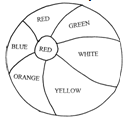
You will need:
One half-ball-shaped wood piece 1 1/2" diameter* (available
at a craft store);
Acrylic paint or permanent markers;
1/2" section of 1/2" PVC pipe;
Thick craft glue or low temp glue gun.
*If you cannot find half-ball shapes, cut a wooden ball in
half. Be careful, it is small and craft wood shapes are usually hardwood.
Adult should do this.
- Paint the wood piece like a beach ball.
- Let it dry.
- Glue the PVC pipe section onto the flat side of the
'beach ball'.
Rope Neckerchief Slide
Santa Clara
County Council
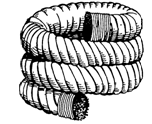
You will need a piece of rope about 8-inches long
and a whipping cord.
Whip both ends of the rope (Bear Achievement 22).
Lay a bead of low temp glue along the rope and coil the
rope in a circle. It may be easier if you wrap the rope around a 1/2" dowel,
being careful not to glue the rope to the dowel.
Buoy Key Ring
Longhorn
Council
You will need a large enough piece of cork and twist
ties
It floats, so it’s a good gift for anglers and boaters.
- Drill a hole through the middle of a cork.
- Insert a large plastic coated twist tie through the
hole in the cork.
- Thread the key onto one end and securely twist the
ties together.
- Test for buoyancy in a sink filled with water. If it
sinks, try a larger cork or add another one.
Footprints in the Sand
Santa Clara
County Council
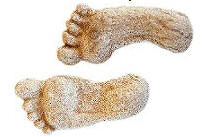
Capture that barefoot-on-the-beach feeling -- and a record
of your feet -- with this simple plaster-casting project.
Supplies: Plaster of Paris, small bucket,
freshwater, 4-inch lengths of string (optional)
Directions:
Choose a site to cast your molds -- the moist, hard-packed
sand near the water's edge works best.
Firmly press both feet into the sand. The prints should be
about 1/2 inch to 2 inches deep. (If your child can't press down that hard, he
can use his finger to dig down into the print, following its shape.)
Mix up the plaster, according to the directions on the
package, so that it has a thick, creamy consistency. Pour the wet plaster gently
into the footprints.
To make hangers, tie a knot about a half-inch in from each
end of the pieces of string. As the plaster begins to harden, push the knotted
ends into the plaster and let dry.
After 20 to 25 minutes, gently dig the footprints out of
the molds and brush away any excess sand. Set sole-side up in the sun for about
an hour to let harden.
Jet Boat I
Santa Clara
County Council
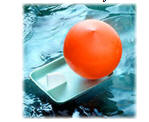
Kids will love being the captain of this balloon-powered
jet boat - perfect for racing in pools, ponds and bathtubs.
Supplies: Plastic pipe elbow, 1/2 inch in
diameter, and its accompanying plastic nut (ask at your local hardware store);
Two 5 1/2 x 8-inch Styrofoam food trays; Balloon; Rubber band
Directions:
Thread the nut on the plastic pipe elbow. Then cut a hole
in the bottom of one of the trays and push through the elbow's non-threaded end.
Stretch the balloon over the threaded end. Next, secure the
elbow underneath the tray with the rubber band, wrapping it around several
times.
Cut a rudder from the other tray, and insert it through a
slit cut in the stern of the boat.
Tips: To operate the vessel, inflate the balloon
by blowing into the elbow. Block the end of the pipe with your finger as you set
the boat in the water, then release it and watch the boat zip away.
Yacht Tie Slide
Baltimore Area
Council
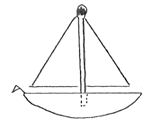
ü
The hull is whittled from white pine or balsa. The mast is a
burned match. The boom is a toothpick. The sail is a triangle of white or red
fabric.
ü
Whittle and sand hull, It is flat on back and curved on front,.
ü
Drill 3 holes, one in top for match mast, 2 in back for plastic or
metal ring cut in half.
ü
Glue mast in place. Glue boom to lower edge of sail.
ü
Glue sail and boom mast and let glue dry,
ü
Glue ring in place, While it is drying, make small flag for stern
from construction paper triangle (tiny) glued to straight pin,.
Build a Boat
Baltimore Area
Council
Materials: Wood shingle, lollipop stick, colored
paper, rubber bands, glue
Directions:
ü
Cut Cardboard template
ü
Trace on to Shingle
ü
Cut out boat outline
ü
Make Paddle
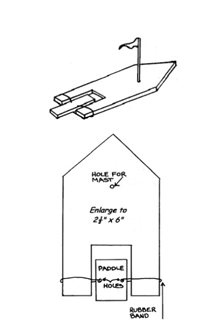
ü
Drill holes for the Rubber Bands
ü
Drill Hole for Mast
ü
Mount Mast
ü
Cut out flag, attach to stick, & Glue
ü
Wind Paddle Up
ü
NOW... LAUNCH YOUR BOAT!
Leather and Button Puzzle
Baltimore Area
Council
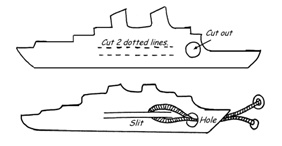
Trick: Remove string and button without untying
buttons.

Trace the ship pattern on
vinyl. Make 2 parallel cuts as per diagram) in center of strip of vinyl. At end
cut hole, slightly larger then the width between the slits. Pass heavy string
under slits, through the hole, and fasten buttons to loose ends of string.
Buttons need to be too large to fit through the hole
To solve the puzzle, fold the
vinyl, pulling the slit away from the body of the vinyl. Fold the slit material
in half and pass it through the hole with the string pinched at the end of the
folded slit. Once the slit and string are through the hole, the button on the
end of the string can be pulled through the loop of vinyl and removed.
Reassemble by reversing the process.
Jet Boat II
Baltimore Area
Council
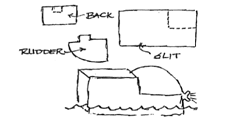
Materials:
Quart milk carton Tape
Scissors Balloon
Cut carton on dotted lines as shown and remove cut section.
Make slit near front bottom for rudder, made from cut out section, and notch in
rear as shown. Tape rudder in place. Place blown up balloon in boat and watch it
go!
Submarine
Baltimore Area
Council
Materials:
2 Plastic
bottles Scissors
Adhesive tape 12” Piece of plastic
tubing
24” Piece of plastic
tubing Clay
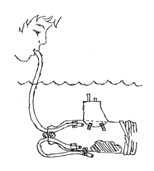
Directions:
ü
Remove cap from bottle.
ü
Cut around bottle 2” from bottom.
ü
Push both pieces of tubing into the bottle through the neck and
secure as shown.
ü
Bend the short piece around and tape it to the outside of the
bottle.
ü
To make it float properly add a large wad of clay inside bottle as
shown. Be careful not to plug tubes.
ü
Use a second piece of clay to make the top air-tight.
ü
Replace bottom of bottle and tape tightly.
ü
Use second bottle to make conning tower, tape in place.
ü
Place sub in water.
ü
Blow into long tube to make it rise and suck air out to make it
sink.
Wave Maker
Circle Ten
Council
Fill a clean, empty, clear plastic soda bottle half full of
water. Add some blue and/or green food coloring, twist on the lid and shake it
to mix the coloring well. Now add vegetable oil nearly to the top (leave about
1” air space). Swirl the bottle while it is standing up or lay it on its side
to watch the waves. Try creating large bubbles by turning the bottle over and
over a few times. Really shake it up to create millions of tiny bubbles.
Sand Paperweight
Circle Ten
Council
Mix some small shells and colored aquarium gravel into some
sand. Pour this mix into a clean baby food jar. Spray paint the lid and screw
it on tight. Set jar upside down on the lid for a paperweight.
Fish Tank Neckerchief Slide
Baltimore Area
Council

Materials needed: Empty Tic Tac container,
construction paper, glue, scissors, colored fish tank beads or plastic gravel or
craft melting beads, PVC pipe ring.
Directions:
ü
Carefully remove lid from Tic Tac container.
ü
Inside glue blue construction paper to the back.
ü
Spread glue on the bottom of the container and put in the colored
fish tank beads or plastic gravel or craft melting beads as a colorful base.
ü
Use construction paper to make small fish and underwater plants.
ü
Glue the plants and some of the fish to the inside of the box. Put
them on both the front and back of the box to give the tank a dimensional look.
ü
Glue PVC pipe ring to the back.
Huck Finn’s Log Raft
Baltimore Area
Council
Materials:
11 twigs of equal thickness liquid white
glue
1 sheet of white paper colored crayons or markers
wax paper.
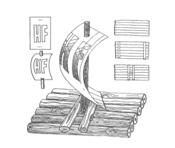
Directions:
ü
Cut twigs a little longer than logs shown In illustration,
ü
Place six twigs on sheet of wax paper.
ü
Clue the twigs together with glue to form raft.
ü
Cut two twigs to fit the width of the six glued twigs.
ü
Glue these two twigs near the ends of the raft.
ü
Let the raft dry overnight. When dry turn upside down.
ü
Cut a twig to form the mast and glue it standing up to the center
of the raft.
ü
Cut a twig to form the last two twigs to fit the width of the
raft.
ü
Clue the remaining two twigs to both sides of the mast.
ü
Dry overnight.
ü
Cut the sail from white paper, decorate. Push sail through
standing twig.
ü
Have a Den race with the boats in your Raingutter Regatta track.
Make a Paper Boat (and tell a story!)
Baltimore Area
Council
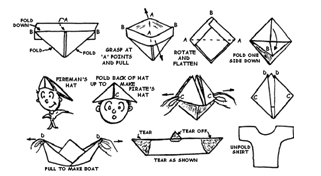
Folding Instructions:
Take a full sheet of newspaper, folded on the center crease with the folded edge
away from you. Take the two upper corners and fold them so that they meet at
exact center. Fold the remaining flaps up, one on each side. Fold and tuck in
the remaining points. Continue refolding following the illustrations outlined
below to make two hats, then the boat.
After completing the boat, you
can tell a funny story as you tear the boat apart (as shown in the last two
steps).
“It was a dark and stormy
night, and a ship was being tossed around off shore. The ship hit a rock, and
the bow was ripped off (tear off one end of the boat as shown). Then it
was whipped around, and the stern was demolished (tear off the other end of
the boat). To make things worse, a bolt of lightening came and knocked off
the mast (tear the top point off the boat). The boat then sank, and all
that was ever found (here’s where you unfold the remains of the paper boat)
was the Captain’s shirt.”
Practice the story and
tearing off the pieces several times by yourself before you try to tell it in
front of an audience!
MORE GAMES AND ACTIVITIES
Sam Houston Area Council

From the Cub Scout Leader How-To Book –
ü
-Water Games – pages 3-42 to 3-47
ü
-Fun with Water and Aquatic Life – pages 4-14 to 4-16
ü
-How to hold a Water Carnival – pages 6-14 to 6-15
ü
-How to hold a Raingutter Regatta – pages 6-32 to 6-33
ü
-How to hold a Fishing Derby – pages 6-37 to 6-38
Materials found in Baloo's Bugle may be used by Scouters for Scouting activities provided that Baloo's Bugle and the original contributors are cited as the source of the material. |
|





